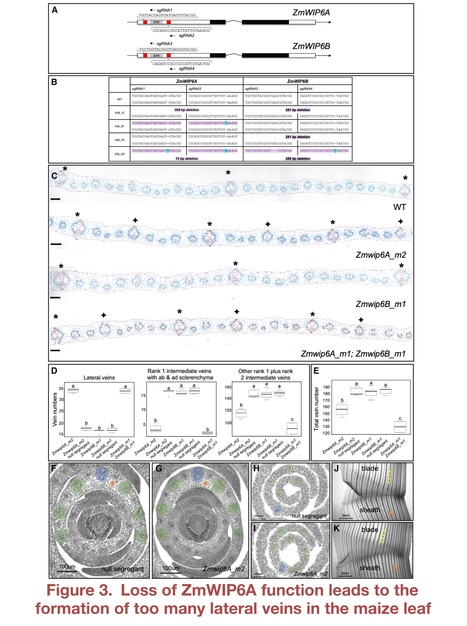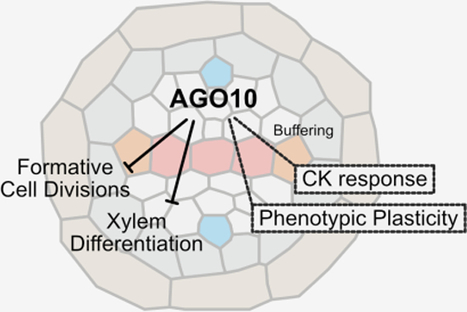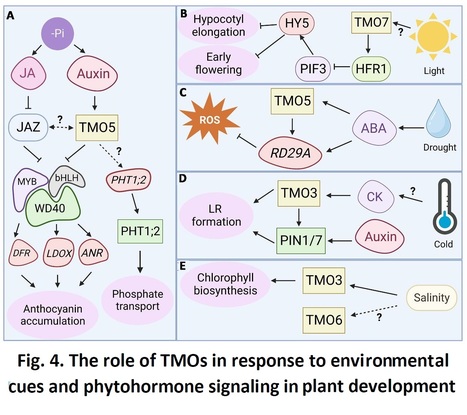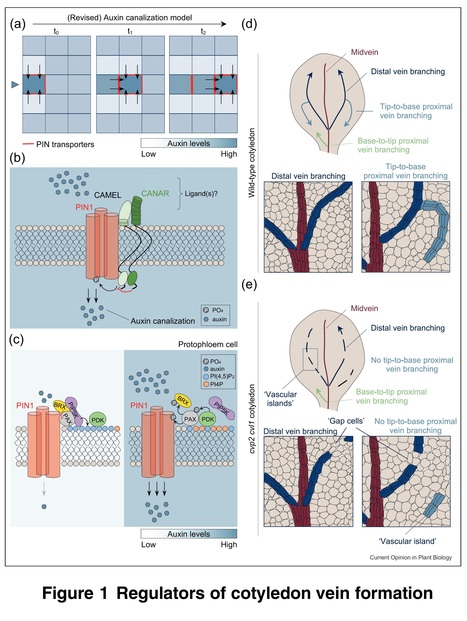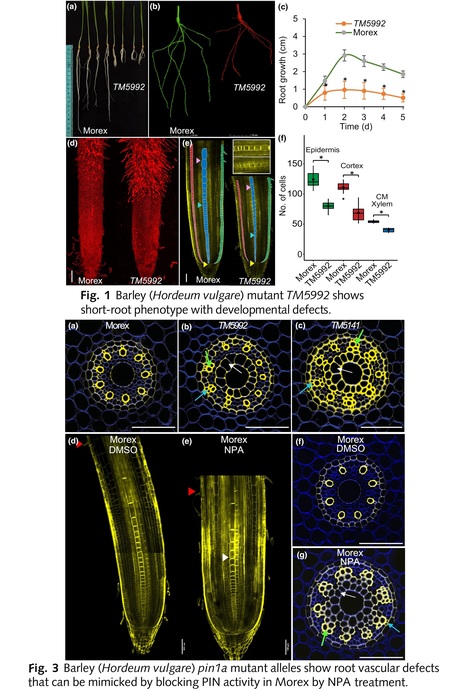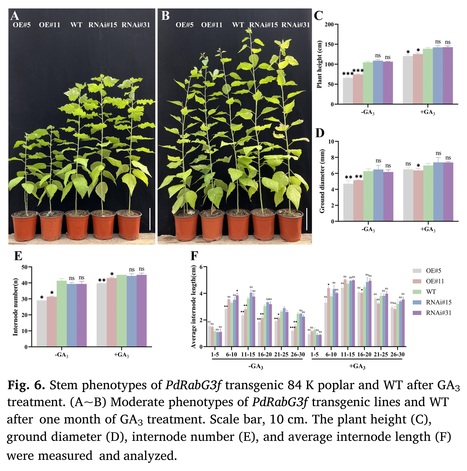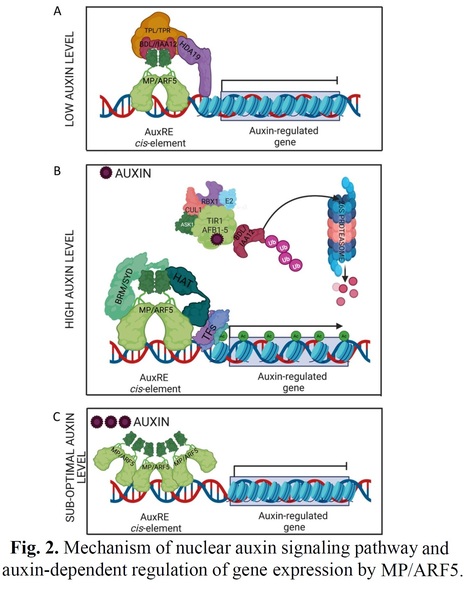 Your new post is loading...
 Your new post is loading...
Authors: Phanu T. Serivichyaswat, Abdul Kareem, Ming Feng and Charles W. Melnyk.
Plant Physiology (2024)
One-sentence summary: Auxin signaling in the cambial tissues promotes cell divisions and drives both tissue attachment and vascular differentiation during successful Arabidopsis grafting.
Abstract: "The strong ability of plants to regenerate wounds is exemplified by grafting when two plants are cut and joined together to grow as one. During graft healing, tissues attach, cells proliferate, and the vasculatures connect to form a graft union. The plant hormone auxin plays a central role, and auxin-related mutants perturb grafting success. Here, we investigated the role of individual cell types and their response to auxin during Arabidopsis (Arabidopsis thaliana) graft formation. By employing a cell-specific inducible misexpression system, we blocked auxin response in individual cell types using the bodenlos mutation. We found that auxin signaling in procambial tissues was critical for successful tissue attachment and vascular differentiation. In addition, we found that auxin signaling was required for cell divisions of the procambial cells during graft formation. Loss of function mutants in cambial pathways also perturbed attachment and phloem reconnection. We propose that cambial and procambial tissues drive tissue attachment and vascular differentiation during successful grafting. Our study thus refines our knowledge of graft development and furthers our understanding of the regenerative role of the cambium."
Authors: Daniela Vlad, Maricris Zaidem, Chiara Perico, Olga Sedelnikova, Samik Bhattacharya and Jane A. Langdale.
Current Biology (2024)
Editor's view: Vlad et al. discover a conserved mechanism that determines whether procambial stem cells in grass leaf primordia will develop into large lateral or smaller intermediate veins. The mechanism is revealed through the analysis of mutants defective in the activity of a zinc finger transcription factor of the WIP6 family that is named TOO MANY LATERALS.
Highlights • Function of WIP6 ortholog TML is conserved in maize and rice • TML is expressed in procambial cells during early leaf vein development • tml mutants develop large lateral veins in places where smaller veins should form • TML function suppresses lateral vein development in a subset of procambial initials
Abstract: "Grass leaves are invariantly strap shaped with an elongated distal blade and a proximal sheath that wraps around the stem. Underpinning this shape is a scaffold of leaf veins, most of which extend in parallel along the proximo-distal leaf axis. Differences between species are apparent both in the vein types that develop and in the distance between veins across the medio-lateral leaf axis. A prominent engineering goal is to increase vein density in leaves of C3 photosynthesizing species to facilitate the introduction of the more efficient C4 pathway. Here, we discover that the WIP6 transcription factor TOO MANY LATERALS (TML) specifies vein rank in both maize (C4) and rice (C3). Loss-of-function tml mutations cause large lateral veins to develop in positions normally occupied by smaller intermediate veins, and TML transcript localization in wild-type leaves is consistent with a role in suppressing lateral vein development in procambial cells that form intermediate veins. Attempts to manipulate TML function in rice were unsuccessful because transgene expression was silenced, suggesting that precise TML expression is essential for shoot viability. This finding may reflect the need to prevent the inappropriate activation of downstream targets or, given that transcriptome analysis revealed altered cytokinin and auxin signaling profiles in maize tml mutants, the need to prevent local or general hormonal imbalances. Importantly, rice tml mutants display an increased occupancy of veins in the leaf, providing a step toward an anatomical chassis for C4 engineering. Collectively, a conserved mechanism of vein rank specification in grass leaves has been revealed.
Authors: Nabila El Arbi, Ann-Kathrin Schürholz, Marlene U. Handl , Alexei Schiffner, Inés Hidalgo Prados, Liese Schnurbusch, Christian Wenzl, Xin’Ai Zhao, Jian Zeng, Jan U. Lohmann and Sebastian Wolf.
EMBO Journal (2024)
Synopsis: In the Arabidopsis root vascular tissue, a gradient of miRNA165/6 controls the abundance of HD-ZIP III transcription factors, which in turn control cell fate and spatially restrict vascular cell proliferation to specific cells. This work shows that vascular development requires ARGONAUTE10 to sequester miRNA165/6, thus protecting HD-ZIP III transcripts from degradation. • AGO10 controls formative cell divisions in the centre of the root stele, with its loss leading to ectopic xylem strands, increased procambial cell number, and enhanced root growth. • Consistent with a role in protecting HD-ZIP III transcripts from miRNA165/6-mediated degradation, AGO10 is mostly expressed in the centre of the meristematic stele. • AGO10 promotes HD-ZIP III activity to suppress cytokinin responses in the stele. • AGO10 mutants outperform the wild type under water-limiting conditions. • However, AGO10 is required for phenotypic robustness upon reduced carbon availability.
Abstract: A key question in plant biology is how oriented cell divisions are integrated with patterning mechanisms to generate organs with adequate cell type allocation. In the root vasculature, a gradient of miRNA165/6 controls the abundance of HD-ZIP III transcription factors, which in turn control cell fate and spatially restrict vascular cell proliferation to specific cells. Here, we show that vascular development requires the presence of ARGONAUTE10, which is thought to sequester miRNA165/6 and protect HD-ZIP III transcripts from degradation. Our results suggest that the miR165/6-AGO10-HDZIP III module acts by buffering cytokinin responses and restricting xylem differentiation. Mutants of AGO10 show faster growth rates and strongly enhanced survival under severe drought conditions. However, this superior performance is offset by markedly increased variation and phenotypic plasticity in sub-optimal carbon supply conditions. Thus, AGO10 is required for the control of formative cell division and coordination of robust cell fate specification of the vasculature, while altering its expression provides a means to adjust phenotypic plasticity.
Authors: Pascal Hunziker and Thomas Greb.
Annual Review of Plant Biology (2024)
Abstract: "Plant vascular tissues are crucial for the long-distance transport of water, nutrients, and a multitude of signal molecules throughout the plant body and, therefore, central to plant growth and development. The intricate development of vascular tissues is orchestrated by unique populations of dedicated stem cells integrating endogenous as well as environmental cues. This review summarizes our current understanding of vascular-related stem cell biology and of vascular tissue differentiation. We present an overview of the molecular and cellular mechanisms governing the maintenance and fate determination of vascular stem cells and highlight the interplay between intrinsic and external cues. In this context, we emphasize the role of transcription factors, hormonal signaling, and epigenetic modifications. We also discuss emerging technologies and the large repertoire of cell types associated with vascular tissues, which have the potential to provide unprecedented insights into cellular specialization and anatomical adaptations to distinct ecological niches."
Authors: Min Chen, Yani Dai, Jiamin Liao, Huan Wu, Qiang Lv, Yu Huang, Lichang Liu, Yu Feng, Hongxuan Lv, Bo Zhou and Dan Peng.
Journal of Experimental Botany (2024)
Abstract: "Plants have an incredible ability to sustain root and vascular growth after initiation of the embryonic root and the specification of vascular tissue in early embryos. Microarray assays have revealed that a group of transcription factors (TARGET OF MONOPTEROS) are important for embryonic root initiation in Arabidopsis. Despite their discovery of auxin responsiveness early on, their function and mode of action remained unknown for many years. The advent of genome editing has accelerated the study of TMO transcription factors, revealing novel functions for biological processes such as vascular development, root system architecture, and response to environmental cues. This review covers recent achievements in understanding the developmental function and the genetic mode of action of TMO transcription factors in Arabidopsis and other plant species. We highlight the transcriptional and post-transcriptional regulation of TMO transcription factors in relation to their function, mainly in Arabidopsis. Finally, we provide suggestions for further research and possible applications in plant genetic engineering."
Authors: Wei Li, Ying-Chung Jimmy Lin, Ying-Lan Chen, Chenguang Zhou, Shuang Li, Nette De Ridder, Dyoni M. Oliveira, Lanjun Zhang, Baocai Zhang, Jack P. Wang, Changzheng Xu, Xiaokang Fu, Keming Luo, Ai-Min Wu, Taku Demura, Meng-Zhu Lu, Yihua Zhou, Laigeng Li, Toshiaki Umezawa, Wout Boerjan and Vincent L. Chiang.
Molecular Plant (2024)
Abstract: "Cell walls in plants, particularly forest trees, are the major carbon sink of the terrestrial ecosystem. Chemical and biosynthetic features of plant cell walls were revealed early on, focusing mostly on herbaceous model species. Recent developments in genomics, transcriptomics, epigenomics, transgenesis, and associated analytical techniques are enabling novel insights into formation of woody cell walls. Here, we review multilevel regulation of cell wall biosynthesis in forest tree species. We highlight current approaches to engineering cell walls as potential feedstock for materials and energy and survey reported field tests of such engineered transgenic trees. We outline opportunities and challenges in future research to better understand cell type biogenesis for more efficient wood cell wall modification and utilization for biomaterials or for enhanced carbon capture and storage."
Authors: Penelope Lindsay, Kyle W. Swentowsky and David Jackson.
Molecular Plant (2024)
Abstract: "Meristems are stem cell-containing structures that produce all plant organs and are therefore important targets for crop improvement. Developmental regulators control the balance and rate of cell divisions within the meristem. Altering these regulators impacts meristem architecture and as a consequence, plant form. In this review, we discuss genes involved in regulating the shoot apical meristem (SAM), inflorescence meristem (IM), axillary meristem (AM), root apical meristem (RAM), and vascular cambium in plants. We also highlight examples of how crop breeders have manipulated developmental regulators to modify meristem growth, altering crop traits including inflorescence size and branching patterns. Plant transformation techniques are another innovation related to plant meristem research, since they make crop genome engineering possible. We discuss recent advances in plant transformation research made possible by studying genes that control meristem development. Finally, we conclude with a discussion of how meristem research can contribute to crop improvement in the coming decades."
Author: Roni Aloni.
In: Progress in Botany, Volume 84 (2024)
Abstract: "Development of plants and animals depends on the formation of complex vascular systems for the delivery of water, nutrients, and hormonal signals. This review clarifies major controlling mechanisms that regulate vascular differentiation, regeneration, adaptation, and evolution of plants, which were discovered during the past 50 years. Hypotheses and evidence on the hormonal mechanisms that regulate vascular differentiation are discussed, focusing on phloem and xylem relationships, control of vessel width, fiber differentiation, leaf and flower development, root initiation, evolution of ring-porous wood, parasitism, gall formation, cancer development and prevention."
Authors: Monika Dalal, Mansi and Karthikeyan Mayandi.
Planta (2023)
Main conclusion: The review describes tissue-specific and non-cell autonomous molecular responses regulating the root system architecture and function in plants.
Abstract: "Phenotypic plasticity of roots relies on specific molecular and tissue specific responses towards local and microscale heterogeneity in edaphic factors. Unlike gravitropism, hydrotropism in Arabidopsis is regulated by MIZU KUSSIE1 (MIZ1)-dependent asymmetric distribution of cytokinin and activation of Arabidopsis response regulators, ARR16 and ARR17 on the lower water potential side of the root leading to higher cell division and root bending. The cortex specific role of Abscisic acid (ABA)-activated SNF1-related protein kinase 2.2 (SnRK2.2) and MIZ1 in elongation zone is emerging for hydrotropic curvature. Halotropism involves clathrin-mediated internalization of PIN FORMED 2 (PIN2) proteins at the side facing higher salt concentration in the root tip, and ABA-activated SnRK2.6 mediated phosphorylation of cortical microtubule-associated protein Spiral2-like (SP2L) in the root transition zone, which results in anisotropic cell expansion and root bending away from higher salt. In hydropatterning, Indole-3-acetic acid 3 (IAA3) interacts with SUMOylated-ARF7 (Auxin response factor 7) and prevents expression of Lateral organ boundaries-domain 16 (LBD16) in air-side of the root, while on wet side of the root, IAA3 cannot repress the non-SUMOylated-ARF7 thereby leading to LBD16 expression and lateral root development. In root vasculature, ABA induces expression of microRNA165/microRNA166 in endodermis, which moves into the stele to target class III Homeodomain leucine zipper protein (HD-ZIP III) mRNA in non-cell autonomous manner. The bidirectional gradient of microRNA165/6 and HD-ZIP III mRNA regulates xylem patterning under stress. Understanding the tissue specific molecular mechanisms regulating the root responses under heterogeneous and stress environments will help in designing climate-resilient crops."
Authors: Noel Blanco-Touriñán and Christian S. Hardtke.
Current Opinion in Plant Biology (2023)
Highlights: • Live-cell imaging reveals the cellular basis for cotyledon vein formation. • New polar auxin transport regulatory mechanisms in vein formation were identified. • Polar auxin transport-independent mechanisms emerge as regulators of vein formation. • scRNA-seq suggests transitional stages for lateral root vascular identity acquisition. • Vasculature formation in lateral roots requires coordination of primary root tissues.
Abstract: "The vascular system was essential for plants to colonize land by facilitating the transport of water, nutrients, and minerals throughout the body. Our current knowledge on the molecular-genetic control of vascular tissue specification and differentiation is mostly based on studies in the Arabidopsis primary root. To what degree these regulatory mechanisms in the root meristem can be extrapolated to vascular tissue development in other organs is a question of great interest. In this review, we discuss the most recent progress on cotyledon vein formation, with a focus on polar auxin transport-dependent and -independent mechanisms. We also provide an overview of vasculature formation in postembryonic organs, namely lateral roots, which is more complex than anticipated as several tissues of the parent root must act in a spatio-temporally coordinated manner."
Authors: Kaitlyn N. Greenwood, Courtney L. King, Isabella Melena, Katherine A. Stegemann, Maura Donnelly, Anna Childers, Raegan Mozal, Carina A. Collins and Benjamin J. Spears.
Plant Direct (2023)
Abstract: "Phloem is a critical tissue for transport of photosynthates and extracellular signals in vascular plants. However, it also represents an ideal environment for pathogens seeking access to valuable host nutrients. Although many vascular pathogens induce economically relevant crop damage, there is still little known about the mechanisms by which immune signaling operates through the phloem. An existing phosphoproteomic dataset was mined to identify proteins that were both phosphorylated in response to the defense-elicitor flagellin (flg22) and expressed in vascular cells. A single candidate, OCTOPUS (OPS), is polarly associated with the plasma membrane of sieve element cells and has been characterized as an inhibitor of brassinosteroid insensitive-2 in promotion of brassinosteroid-related phytohormone signaling. The observation that OPS is differentially phosphorylated in response to flg22 led us to the examine whether OPS may also regulate flg22-induced immune signaling. Two independent alleles of ops exhibited enhanced immunity outputs across multiple signaling branches of PAMP-triggered immunity (PTI), constitutively and in response to flg22 treatment. Together with our observation that interactions between OPS and brassinosteroid insensitive-2 were disrupted by induction of salicylic acid and depletion of brassinosteroid, these data support a model whereby OPS modulates brassinolide and immune signaling to control downstream responses. We present OPS as a novel addition to the list of proteins with documented roles in PAMP-PTI signaling. These results further indicate that immune signaling in the phloem may be a significant and unique component of the host detection and response to pathogens in vascular plants."
Authors: Vojtech Didi, Dominique Arnaud, Anna Pacinkova, Radek Jupa, Radim Cegan, Alesia Melnikava, Jana Vasickova, Mariana Benitez, Faride Unda, Tereza Dobisova, Willi Riber, Zuzana Dostalova, Shawn D. Mansfield, Ondrej Novak, Miroslav Strnad, Roman Hobza, Vit Gloser, Eva Budinska and Jan Hejatko.
bioRxiv (2023)
Abstract: "Spatiotemporal control over developmental programs is vital to all organisms. Here we show that cytokinin (signaling) deficiency leads to early secondary cell wall (SCW) formation in Arabidopsis inflorescence stem that associates with precocious upregulation of a SCW transcriptional cascade controlled by NAC TFs (NSTs). We demonstrate that cytokinin signaling through the AHK2/3 and the ARR1/10/12 suppresses the expression of several NSTs and SCW formation in the apical portions of stems. Exogenous cytokinin application reconstituted both proper development and apical-basal gradient of NST1 and NST3 in a cytokinin biosynthesis-deficient mutant. We show that AHK2 and AHK3 required functional NST1 or NST3 to control SCW initiation in the interfascicular fibers, further evidencing that cytokinins act upstream of NSTs transcription factors. The premature onset of a rigid SCW biosynthesis and altered expression of NST1/3 and VND6/7 due to cytokinin deficiency led to the formation of smaller tracheary elements (TEs) and impaired hydraulic conductivity. We conclude that cytokinins downregulate NSTs to inhibit premature SCW formation in the apical part of the inflorescence stem, facilitating thus the development of fully functional TEs and interfascicular fibers."
Authors: Phanu T. Serivichyaswat, Abdul Kareem, Ming Feng and Charles W. Melnyk.
bioRxiv (2023)
Abstract: The remarkable ability of plants to regenerate wounds is exemplified during the process of plant grafting when two plants are cut and joined together to grow as one. During graft healing, damaged tissues attach, cells proliferate and the vasculatures connect to form a graft union. The plant hormone auxin plays a central role and mutants perturbed in auxin response fail to successfully graft. Here, we investigated the role of individual cell types and their response to auxin during Arabidopsis thaliana graft formation. By employing an inducible misexpression system, we blocked auxin response in individual cell types using the bodenlos mutation. We found that auxin signaling in procambial tissues was critical for both successful tissue attachment and also for vascular differentiation. In addition, we found that auxin signaling was required for cell divisions of the procambial cells during graft formation. Loss of function mutants in cambial pathways also perturbed attachment and phloem reconnection. We propose that cambium and procambium are key tissues that allow both tissue attachment and vascular differentiation during successful grafting. Our study thus refines our knowledge of graft development and furthers our understanding of regeneration biology and the function of cambium."
|
Authors: Riccardo Fusi, Sara Giulia Milner, Serena Rosignoli, Riccardo Bovina, Cristovão De Jesus Vieira Teixeira, Haoyu Lou, Brian S. Atkinson, Aditi N. Borkar, Larry M. York, Dylan H. Jones, Craig J. Sturrock, Nils Stein, Martin Mascher, Roberto Tuberosa, Devin O'Connor, Malcolm J. Bennett, Anthony Bishopp, Silvio Salvi and Rahul Bhosale.
New Phytologist (2024)
Abstract: "Barley (Hordeum vulgare) is an important global cereal crop and a model in genetic studies. Despite advances in characterising barley genomic resources, few mutant studies have identified genes controlling root architecture and anatomy, which plays a critical role in capturing soil resources. Our phenotypic screening of a TILLING mutant collection identified line TM5992 exhibiting a short-root phenotype compared with wild-type (WT) Morex background. Outcrossing TM5992 with barley variety Proctor and subsequent SNP array-based bulk segregant analysis, fine mapped the mutation to a cM scale. Exome sequencing pinpointed a mutation in the candidate gene HvPIN1a, further confirming this by analysing independent mutant alleles. Detailed analysis of root growth and anatomy in Hvpin1a mutant alleles exhibited a slower growth rate, shorter apical meristem and striking vascular patterning defects compared to WT. Expression and mutant analyses of PIN1 members in the closely related cereal brachypodium (Brachypodium distachyon) revealed that BdPIN1a and BdPIN1b were redundantly expressed in root vascular tissues but only Bdpin1a mutant allele displayed root vascular defects similar to Hvpin1a. We conclude that barley PIN1 genes have sub-functionalised in cereals, compared to Arabidopsis (Arabidopsis thaliana), where PIN1a sequences control root vascular patterning."
Authors: Jiujun Du, Hantian Wei, Xueqin Song, Lei Zhang and Jianjun Hu.
Plant Science (2024)
Highlights: • PdRabG3f inhibited the vertical elongation of poplar by suppressing internode elongation. • PdRabG3f inhibited xylem development by suppressing cambium division and differentiation. • PdRabG3f interfered with gibberellin-mediated internode elongation and xylem developing in poplar.
Abstract: "As a member of the small GTPases family, Rab GTPases play a key role in specifying transport pathways in the intracellular membrane trafficking system and are involved in plant growth and development. By quantitative trait locus (QTL) mapping, PdRabG3f was identified as a candidate gene associated with shoot height in a hybrid offspring of Populus deltoides ‘Danhong’ × Populus simonii ‘Tongliao1’. PdRabG3f localized to the nucleus, endoplasmic reticulum and tonoplast and was primarily expressed in the xylem and cambium. Overexpression of PdRabG3f in Populus alba × Populus glandulosa (84 K poplar) had inhibitory effects on vertical and radical growth. In the transgenic lines, there were evident changes in the levels of 15 gibberellin (GA) derivatives, and the application of exogenous GA3 partially restored the phenotypes mediated by GAs deficiency. The interaction between PdRabG3f and RIC4, which was the GA-responsive factor, provided additional explanation for PdRabG3f's inhibitory effect on poplar growth. RNA-seq analysis revealed differentially expressed genes (DEGs) associated with cell wall, xylem, and gibberellin response. PdRabG3f interfering endogenous GAs levels in poplar might involve the participation of MYBs and ultimately affected internode elongation and xylem development. This study provides a potential mechanism for gibberellin-mediated regulation of plant growth through Rab GTPases."
Authors: Tomoyuki Furuya, Kyoko Ohashi-Ito and Yuki Kondo.
Plant and Cell Physiology (2024)
Abstract: "Brassinosteroids (BRs) are plant steroid hormones that control growth and stress responses. In the context of development, BRs play diverse roles in controlling cell differentiation and tissue patterning. The vascular system, which is essential for transporting water and nutrients throughout the plant body, initially establishes a tissue pattern during primary development and then dramatically increases the number of vascular cells during secondary development. This complex developmental process is properly regulated by a network consisting of various hormonal signalling pathways. Genetic studies have revealed that mutants defective in BR biosynthesis or the BR signalling cascade exhibit a multifaceted vascular development phenotype. Furthermore, BR crosstalk with other plant hormones, including peptide hormones, coordinately regulates vascular development. Recently, the involvement of BR in vascular development, especially in xylem differentiation, has also been suggested in plant species other than the model plant Arabidopsis thaliana. In this review, we briefly summarize the recent findings on the roles of BR in primary and secondary vascular development in Arabidopsis and other species."
Author: Miguel A. Blázquez.
Annual Review of Plant Biology (2024)
Abstract: "This review focuses on the intricate relationship between plant polyamines and the genetic circuits and signaling pathways that regulate various developmental programs and the defense responses of plants when faced with biotic and abiotic aggressions. Particular emphasis is placed on genetic evidence supporting the involvement of polyamines in specific processes, such as the pivotal role of thermospermine in regulating xylem cell differentiation and the significant contribution of polyamine metabolism in enhancing plant resilience to drought. Based on the numerous studies describing effects of the manipulation of plant polyamine levels, two conceptually different mechanisms for polyamine activity are discussed: direct participation of polyamines in translational regulation and the indirect production of hydrogen peroxide as a defensive mechanism against pathogens. By describing the multifaceted functions of polyamines, this review underscores the profound significance of these compounds in enabling plants to adapt and thrive in challenging environments."
Authors: Xiaokang Fu, Yufeng Xin, Gui Shen, Keming Luo, Changzheng Xu and Nengbiao Wu.
Tree Physiology (2024)
Abstract: "Wood formation is a complex developmental process under the control of multiple levels of regulatory transcriptional network and hormone signals in trees. It is well known that cytokinin signaling plays an important role in maintaining the activity of the vascular cambium. Cytokinin Response Factors (CRFs) encoding a subgroup of AP2 transcription factors have been identified to mediate the cytokinin-dependent regulation in different plant developmental processes. However, the functions of CRFs in wood development remain unclear. Here, we characterized the function of PtCRF1, a CRF transcription factor isolated from poplar, in the process of wood formation. PtCRF1 is preferentially expressed in secondary vasculature, especially in vascular cambium and secondary phloem, and encodes a transcriptional activator. Overexpression of PtCRF1 in transgenic poplar plants led to a significant reduction in the cell layer number of vascular cambium. The development of wood tissue was largely promoted in the PtCRF1-overexpressing lines, while significantly compromised in the CRISPR/Cas9-generated double mutant plants of PtCRF1 and its closest homolog PtCRF2. RNA-seq and RT-qPCR analyses showed that PtCRF1 repressed the expression of the typical cytokinin responsive genes. Furthermore, bimolecular fluorescence complementation assays revealed that PtCRF1 competitively inhibits the direct interactions between histidine phosphotransfer proteins (PtHPs) and type-B Response Regulator (RR) by binding to HP protein. Collectively, these results indicate that PtCRF1 negatively regulates cytokinin signaling and is required for woody cell differentiation in poplar."
Authors: Linjun Peng, Huimin Liu, Yu Wu, Jie Bing and Genfa Zhang.
Plant Growth Regulation (2024)
Abstract: "Plant stem growth is important in plant aerial parts and not only affects plant biomass but is also related to plant defense against the external environment. Thus, the regulation of stem growth has attracted increased attention and has been extensively studied. Plant stems require appropriate development to improve their adaptation to various environmental conditions. The stem growth stage can be divided into two parts, stem elongation and stem thickness, which belong to the primary growth and secondary growth of the stem, respectively. The regulatory mechanism is controlled by a sophisticated genetic network including interactions among various molecules, which work individually or coordinate with others. Recently, plant hormones have been reported to be core regulators in stem growth, in combination with other components such as transcription factors and noncoding RNAs. However, few comprehensive overviews of plant stem growth alone have been reported. This review discusses the mechanisms of phytohormones, transcription factors, and noncoding RNAs involved in the regulatory network of main stem growth during the process of primary stem development in vascular plants and provides references for improving plant architecture in the future."
Authors: Qin Song, Lingfei Kong, Jiarui Yang, Minghui Lin, Yuqian Zhang, Xuerui Yang, Xiaojing Wang, Zhengjie Zhao, Meng Zhang, Jiarui Pan, Shunqin Zhu, Bo Jiao, Changzheng Xu and Keming Luo.
The Plant Journal (2024)
Abstract: "Drought stress caused by global warming has resulted in significant tree mortality, driving the evolution of water conservation strategies in trees. Although phytohormones have been implicated in morphological adaptations to water deficits, the molecular mechanisms underlying these processes in woody plants remain unclear. Here, we report that overexpression of PtoMYB142 in Populus tomentosa results in a dwarfism phenotype with reduced leaf cell size, vessel lumen area, and vessel density in the stem xylem, leading to significantly enhanced drought resistance. We found that PtoMYB142 modulates gibberellin catabolism in response to drought stress by binding directly to the promoter of PtoGA2ox4, a GA2-oxidase gene induced under drought stress. Conversely, knockout of PtoMYB142 by the CRISPR/Cas9 system reduced drought resistance. Our results show that the reduced leaf size and vessel area, as well as the increased vessel density, improve leaf relative water content and stem water potential under drought stress. Furthermore, exogenous GA3 application rescued GA-deficient phenotypes in PtoMYB142-overexpressing plants and reversed their drought resistance. By suppressing the expression of PtoGA2ox4, the manifestation of GA-deficient characteristics, as well as the conferred resistance to drought in PtoMYB142-overexpressing poplars, was impeded. Our study provides insights into the molecular mechanisms underlying tree drought resistance, potentially offering novel transgenic strategies to enhance tree resistance to drought."
Authors: Keming Luo, Shuai Liu, Xiaokang Fu, Xuelian Du, Jian Hu, Lianjia Luo, Changjian Fa, Rongling Wu, Laigeng Li and Changzheng Xu.
Research Square (2023)
Abstract: "Auxin, as a vital phytohormone, is enriched in the vascular cambium, playing a crucial role in regulating wood formation in trees. Despite its significance, the molecular mechanisms underlying the influence of auxin on wood development remain elusive. In this study, we report a transcription factor, PLETHORA 5 (PLT5), whose expression was specifically activated by auxin signalling in the vascular cambium. PLT5 was found to regulate cell expansion and lignification of fibres in poplar. Genetic experiments confirmed the noncell-autonomous regulation of auxin signalling from the vascular cambium and revealed the necessity of PLT5 protein mobility to mediate this process. Remarkably, PLT5 proteins specifically inhibit the initiation of fibre cell wall thickening by directly repressing SND1 genes. This study unveils a sophisticated model wherein the auxin-PLT5 signalling cascade intricately regulates wood fibre development in poplar by fine-tuning the thickening of fibre cell walls."
Authors: János Urbancsok, Evgeniy N. Donev, Pramod Sivan, Elena van Zalen, Félix R. Barbut, Marta Derba-Maceluch, Jan Šimura, Zakiya Yassin, Madhavi L. Gandla, Michal Karady, Karin Ljung, Sandra Winestrand, Leif J. Jönsson, Gerhard Scheepers, Nicolas Delhomme, Nathaniel R. Street and Ewa J. Mellerowicz.
New Phytologist (2023)
Abstract: "Stem bending in trees induces flexure wood but its properties and development are poorly understood. Here, we investigated the effects of low-intensity multidirectional stem flexing on growth and wood properties of hybrid aspen, and on its transcriptomic and hormonal responses. Glasshouse-grown trees were either kept stationary or subjected to several daily shakes for 5 wk, after which the transcriptomes and hormones were analyzed in the cambial region and developing wood tissues, and the wood properties were analyzed by physical, chemical and microscopy techniques. Shaking increased primary and secondary growth and altered wood differentiation by stimulating gelatinous-fiber formation, reducing secondary wall thickness, changing matrix polysaccharides and increasing cellulose, G- and H-lignin contents, cell wall porosity and saccharification yields. Wood-forming tissues exhibited elevated jasmonate, polyamine, ethylene and brassinosteroids and reduced abscisic acid and gibberellin signaling. Transcriptional responses resembled those during tension wood formation but not opposite wood formation and revealed several thigmomorphogenesis-related genes as well as novel gene networks including FLA and XTH genes encoding plasma membrane-bound proteins. Low-intensity stem flexing stimulates growth and induces wood having improved biorefinery properties through molecular and hormonal pathways similar to thigmomorphogenesis in herbaceous plants and largely overlapping with the tension wood program of hardwoods."
Authors: Lingfei Kong, Qin Song, Hongbin Wei, Yanhong Wang, Minghui Lin, Kuan Sun, Yuqian Zhang, Jiarui Yang, Chaofeng Li and Keming Luo.
New Phytologist (2023)
Abstract: "Drought stress is one of the major limiting factors for the growth and development of perennial trees. Xylem vessels act as the center of water conduction in woody species, but the underlying mechanism of its development and morphogenesis under water-deficient conditions remains elucidation. Here, we identified and characterized an osmotic stress-induced ETHYLENE RESPONSE FACTOR 15 (PtoERF15) and its target, PtoMYC2b, which was involved in mediating vessel size, density, and cell wall thickness in response to drought in Populus tomentosa. PtoERF15 is preferentially expressed in differentiating xylem of poplar stems. Overexpression of PtoERF15 contributed to stem water potential maintaining, thus promoting drought tolerance. RNA-Seq and biochemical analysis further revealed that PtoERF15 directly regulated PtoMYC2b, encoding a switch of JA signaling pathway. Additionally, our findings verify that three sets of homologous genes from NAC (NAM, ATAF1/2, and CUC2) gene family: PtoSND1-A1/A2, PtoVND7-1/7-2, and PtoNAC118/120, as the targets of PtoMYC2b, are involved in the regulation of vessel morphology in poplar. Collectively, our study provides molecular evidence for the involvement of the PtoERF15-PtoMYC2b transcription cascade in maintaining stem water potential through the regulation of xylem vessel development, ultimately improving drought tolerance in poplar."
Authors: Eduardo J. Haverroth, Leonardo A. Oliveira, Moab T. Andrade, Matthew Taggart, Scott A. M. McAdam, Agustin Zsögön, Andrew J. Thompson, Samuel C. V. Martins and Amanda A. Cardoso.
Plant, Cell & Environment (2023)
Abstract: "Drought resistance is essential for plant production under water-limiting environments. Abscisic acid (ABA) plays a critical role in stomata but its impact on hydraulic function beyond the stomata is far less studied. We selected genotypes differing in their ability to accumulate ABA to investigate its role in drought-induced dysfunction. All genotypes exhibited similar leaf and stem embolism resistance regardless of differences in ABA levels. Their leaf hydraulic resistance was also similar. Differences were only observed between the two extreme genotypes: sitiens (sit; a strong ABA-deficient mutant) and sp12 (a transgenic line that constitutively overaccumulates ABA), where the water potential inducing 50% embolism was 0.25 MPa lower in sp12 than in sit. Maximum stomatal and minimum leaf conductances were considerably lower in plants with higher ABA (wild type [WT] and sp12) than in ABA-deficient mutants. Variations in gas exchange across genotypes were associated with ABA levels and differences in stomatal density and size. The lower water loss in plants with higher ABA meant that lethal water potentials associated with embolism occurred later during drought in sp12 plants, followed by WT, and then by the ABA-deficient mutants. Therefore, the primary pathway by which ABA enhances drought resistance is via declines in water loss, which delays dehydration and hydraulic dysfunction."
Authors: Barbara Wójcikowska, Samia Belaidi and Hélène S. Robert.
Journal of Experimental Botany (2023)
Abstract: "For many years, research has been carried out to understand the mechanism of auxin action, its biosynthesis, catabolism, perception, and transport. One central interest is understanding the auxin-dependent gene expression regulation mechanism involving AUXIN RESPONSE FACTOR (ARF) transcription factors and their repressors, the AUXIN/INDOLE-3-ACETIC ACID (Aux/IAA) proteins. Numerous studies have been focused on the MONOPTEROS (MP)/ARF5, an activator of auxin-dependent gene expression with a crucial impact on plant development. This review paper summarizes over thirty years of research on MP/ARF5. We indicate the available analytical tools to study MP/ARF5 and point out the known mechanism of MP/ARF5-dependent regulation of gene expression during various developmental processes, i.e., embryogenesis, leaf formation, vascularization, and shoot and root meristem formation. However, many questions remain about the auxin-dose-dependent regulation of gene transcription by MP/ARF5 and its isoforms in plant cells, the composition of the MP/ARF5 protein complex, and finally, the list of genes under its direct control. In addition, the information on post-translational modifications of MP/ARF5 protein is marginal, and knowledge about their consequences on MP/ARF5 function is limited. Moreover, the epigenetic factors and other regulators that act upstream of MP/ARF5 are poorly understood. Their identification will be a challenge in the coming years."
|



 Your new post is loading...
Your new post is loading...



